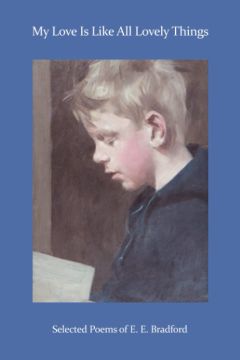My Love Is Like All Lovely Things (book): Difference between revisions
No edit summary |
|||
| Line 1: | Line 1: | ||
[[File:My Love Is Like All Lovely Things.jpg|240 px|right]] | [[File:My Love Is Like All Lovely Things.jpg|240 px|right]] | ||
'''My Love Is Like All Lovely Things | |||
''' | |||
==Author== | |||
[[Edwin Emmanuel Bradford]] (1860–1944) was one of the [[Uranians]], that group of late-Victorian and early-20th-century poets and prose writers who, often taking inspiration from classical Greece, sang the praises of the love between boys and men and advocated its rehabilitation in society. Virtually his entire poetic body of work – twelve volumes that appeared between 1908 and 1930 – is dedicated openly to this theme. Rather than looking back to classical antiquity, it is rooted largely in his own time and experience. | [[Edwin Emmanuel Bradford]] (1860–1944) was one of the [[Uranians]], that group of late-Victorian and early-20th-century poets and prose writers who, often taking inspiration from classical Greece, sang the praises of the love between boys and men and advocated its rehabilitation in society. Virtually his entire poetic body of work – twelve volumes that appeared between 1908 and 1930 – is dedicated openly to this theme. Rather than looking back to classical antiquity, it is rooted largely in his own time and experience. | ||
Revision as of 14:41, 1 May 2023

My Love Is Like All Lovely Things
Author
Edwin Emmanuel Bradford (1860–1944) was one of the Uranians, that group of late-Victorian and early-20th-century poets and prose writers who, often taking inspiration from classical Greece, sang the praises of the love between boys and men and advocated its rehabilitation in society. Virtually his entire poetic body of work – twelve volumes that appeared between 1908 and 1930 – is dedicated openly to this theme. Rather than looking back to classical antiquity, it is rooted largely in his own time and experience.
Bradford’s poetry is exhilaratingly fresh, original, joyful and touching. It is a self-assured, unapologetic affirmation of what is good and beautiful, making it very relevant to readers today. This anthology draws on the entirety of his poetic output and includes the first in-depth look at his life and work, addressing questions such as how his boy-love poetry could have been received so favourably in early-20th-century Britain.[1]